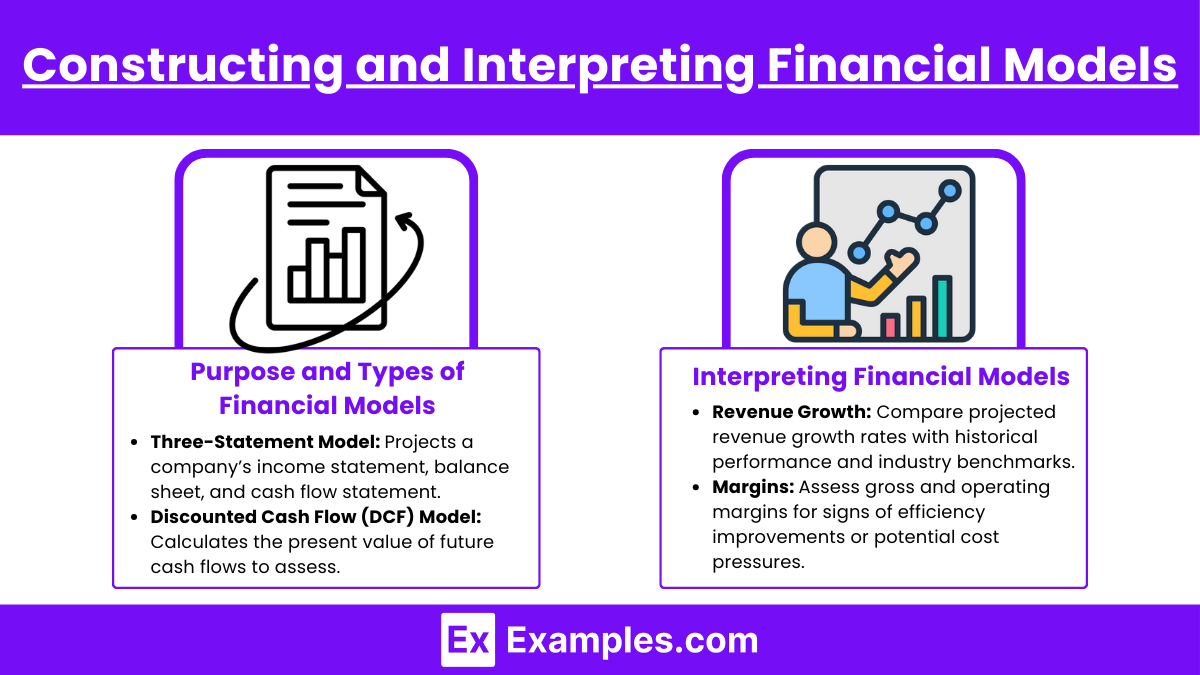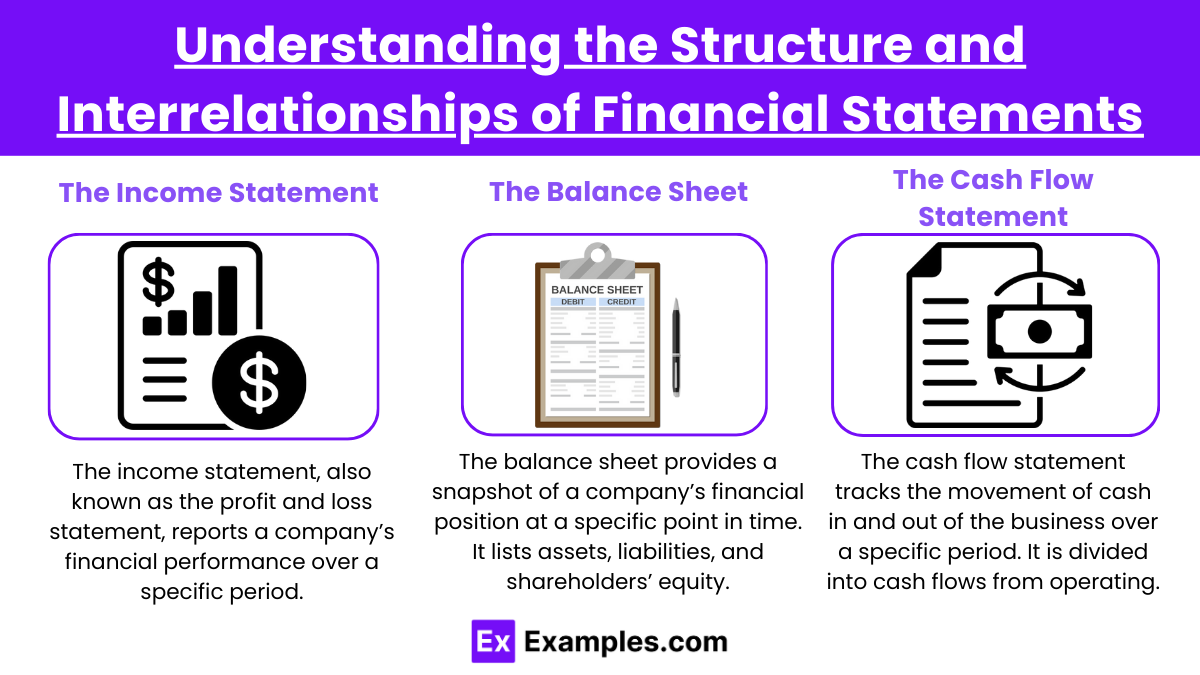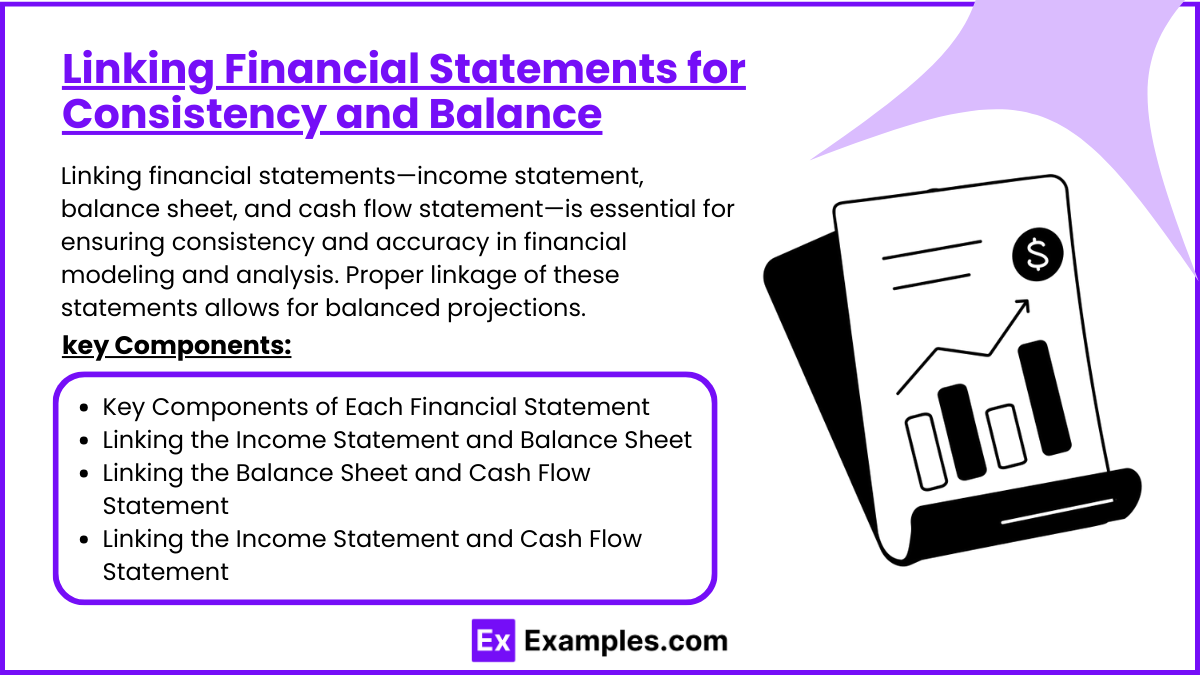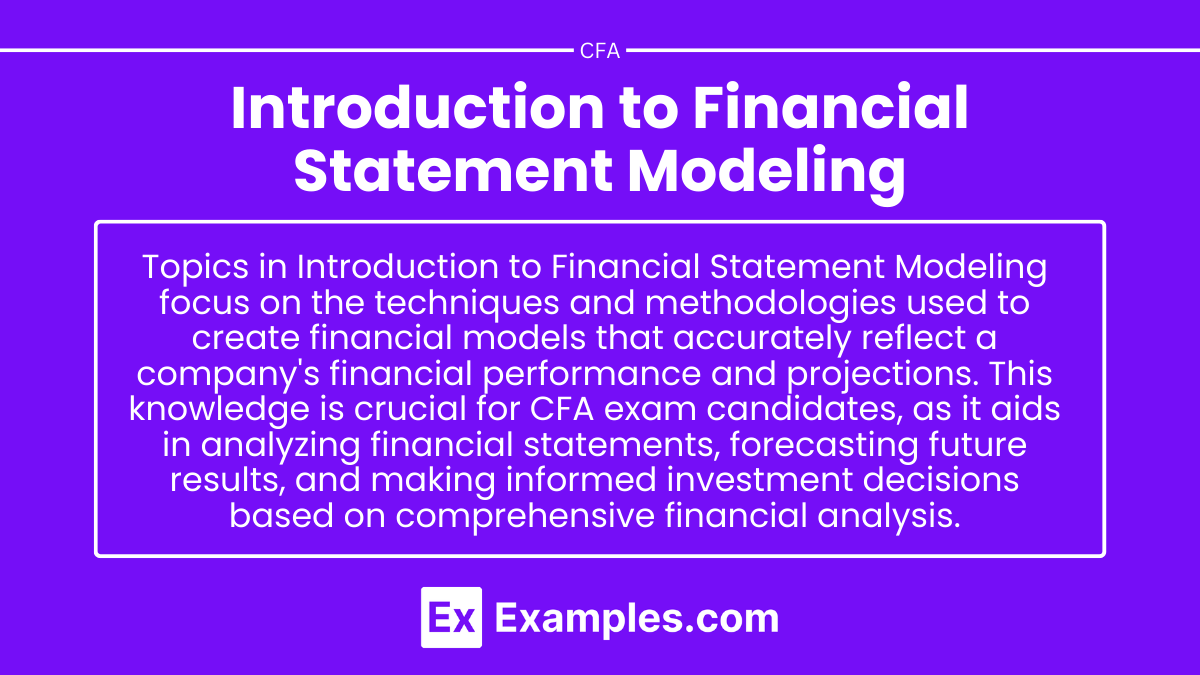Introduction to Financial Statement Modeling provides a foundation in analyzing and projecting a company’s financial performance. This topic focuses on constructing financial models that integrate income statements, balance sheets, and cash flow statements, enabling insights into a firm’s future earnings and financial health. Key areas include assumptions in revenue growth, expense drivers, working capital changes, and capital structure impacts. Mastery of these concepts is essential for accurately forecasting financial outcomes, supporting valuation analyses, and making informed investment decisions, all of which are critical skills in finance and investment analysis.
Learning Objectives
In studying “Introduction to Financial Statement Modeling” for the CFA, you should learn to construct and interpret financial models that project a company’s financial performance based on historical data and assumptions. Understand the structure and interrelationships of the income statement, balance sheet, and cash flow statement within a financial model. Analyze how assumptions, such as revenue growth, expense ratios, and capital expenditures, impact future projections. Develop skills in linking financial statements accurately to ensure consistency and balance. Evaluate key metrics and ratios derived from financial models to assess profitability, liquidity, and solvency. Additionally, practice scenario and sensitivity analysis to understand how changes in assumptions affect financial outcomes, enabling better investment decision-making.
Constructing and Interpreting Financial Models

Financial models are quantitative tools that help companies project financial performance, analyze investment opportunities, and make strategic decisions. By constructing and interpreting financial models, analysts can simulate various scenarios, assess potential risks, and estimate key metrics like revenue, expenses, cash flow, and profitability. Here’s an overview of the key steps involved in constructing financial models, as well as techniques for interpreting their outputs.
Purpose and Types of Financial Models
Before constructing a financial model, it’s essential to determine its purpose, as different models serve different objectives:
- Three-Statement Model: Projects a company’s income statement, balance sheet, and cash flow statement over a specific period, providing a comprehensive view of its financial health.
- Discounted Cash Flow (DCF) Model: Calculates the present value of future cash flows to assess the intrinsic value of an investment or company.
- Budget and Forecast Model: Helps in budgeting expenses and projecting revenue for a specific period, guiding day-to-day operations and strategic planning.
- Merger and Acquisition (M&A) Model: Evaluates the financial impact of mergers, acquisitions, or investments on the target and acquiring companies.
- Sensitivity and Scenario Models: Analyzes the effect of changes in key variables, such as revenue growth, interest rates, or operating expenses, on financial outcomes.
Example: A tech startup might use a three-statement model to estimate cash flow needs for the next year, while a manufacturing firm may rely on a DCF model to evaluate a potential acquisition’s future cash flows.
Interpreting Financial Models
Once a financial model is constructed, interpreting its results is crucial for informed decision-making. Key areas to analyze include profitability, cash flow, return metrics, and risk factors.
Profitability and Growth Analysis
Evaluate projected revenue, gross margin, operating margin, and net profit margin to understand the company’s profitability potential.
Example: A retail model might show steady revenue growth but declining margins, prompting management to review cost management strategies.
Cash Flow Analysis
Analyze cash flow from operations, investing, and financing to assess liquidity and funding needs.
- Cash from Operations: High operating cash flow indicates strong cash-generating potential, while negative cash flow may signal funding gaps.
- Free Cash Flow: Evaluate free cash flow for capital reinvestment opportunities, debt reduction, or shareholder distributions.
Example: A model showing positive free cash flow over several years might support dividend increases or strategic acquisitions.
Return on Investment Metrics
Evaluate return metrics, such as return on equity (ROE), return on assets (ROA), and internal rate of return (IRR) for project-based models, to assess profitability relative to capital.
- ROE and ROA: Assess these ratios to gauge efficiency in using capital and assets to generate profit.
- IRR and Net Present Value (NPV): In investment models, these metrics determine the profitability of specific projects or acquisitions.
Example: A DCF model with an IRR above the company’s cost of capital would indicate a potentially profitable investment.
Sensitivity and Scenario Analysis
Conduct sensitivity analysis by adjusting key variables, such as revenue growth, interest rates, or cost assumptions, to observe how changes impact financial performance.
- Sensitivity Analysis: Adjust individual variables to see their impact on the bottom line, helping identify critical factors and potential risks.
- Scenario Analysis: Model different scenarios (e.g., best-case, worst-case) to understand the range of possible outcomes and assess financial resilience.
Example: A scenario analysis for an energy company might include low, base, and high oil price forecasts to evaluate profit volatility.
Understanding the Structure and Interrelationships of Financial Statements

Financial statements provide a comprehensive view of a company’s financial health, covering its performance, position, and cash flows. The three primary financial statements—income statement, balance sheet, and cash flow statement—are interconnected and together give a complete picture of a company’s financial status. Understanding the structure of each statement and the ways they interrelate is crucial for accurate analysis and informed decision-making.
1. The Income Statement
The income statement, also known as the profit and loss statement, reports a company’s financial performance over a specific period. It includes revenues, expenses, and net income, reflecting the company’s ability to generate profit.
Structure of the Income Statement
- Revenue: Total sales or income generated from core business activities.
- Cost of Goods Sold (COGS): Direct costs of producing goods or services sold.
- Gross Profit: Revenue minus COGS, indicating profitability before operating expenses.
- Operating Expenses: Expenses incurred in running the business, including selling, general, and administrative (SG&A) costs.
- Operating Income: Gross profit minus operating expenses, showing core business profitability.
- Interest and Taxes: Expenses related to financing (interest) and corporate taxes.
- Net Income: The final profit after all expenses, also known as the bottom line.
Example: A technology company’s income statement might show high gross profit but lower net income due to high R&D expenses, affecting overall profitability.
2. The Balance Sheet
The balance sheet provides a snapshot of a company’s financial position at a specific point in time. It lists assets, liabilities, and shareholders’ equity, showing what the company owns, owes, and the equity stake of shareholders.
Structure of the Balance Sheet
- Assets: Divided into current assets (cash, accounts receivable, inventory) and non-current assets (property, equipment, intangible assets). Assets represent resources owned by the company.
- Liabilities: Divided into current liabilities (accounts payable, short-term debt) and long-term liabilities (long-term debt, lease obligations). Liabilities are obligations the company must settle in the future.
- Shareholders’ Equity: Represents the residual interest in assets after liabilities are deducted, including common stock, retained earnings, and other equity components.
The balance sheet follows the fundamental accounting equation: Assets = Liabilities + Equity.
Example: A retail company’s balance sheet might show substantial current assets in inventory, reflecting the nature of the business, while long-term assets may include store properties and equipment.
3. The Cash Flow Statement
The cash flow statement tracks the movement of cash in and out of the business over a specific period. It is divided into cash flows from operating, investing, and financing activities, providing insight into the company’s liquidity and cash management.
Structure of the Cash Flow Statement
- Operating Activities: Cash flows generated by core business activities, adjusting net income for non-cash items (e.g., depreciation) and changes in working capital.
- Investing Activities: Cash flows related to asset acquisitions, investments, or sales, reflecting long-term capital allocation.
- Financing Activities: Cash flows from financing sources, such as debt issuance, debt repayment, or dividend payments, showing how the company funds its operations.
Example: A manufacturing company’s cash flow statement may show negative cash flow from investing activities due to machinery purchases, but positive cash flow from financing activities if the company raised debt to fund these investments.
Analyzing Assumptions and Their Impact on Future Projections

When developing future projections for financial models or business forecasts, assumptions play a central role in shaping the projected outcomes. Assumptions underpin key metrics such as revenue growth, expense trends, capital needs, and market conditions. Analyzing these assumptions and their potential impact allows for more accurate, reliable, and insightful forecasts, helping stakeholders make informed decisions.
1. Importance of Assumptions in Financial Projections
Assumptions are the foundation of any projection, as they provide the framework on which all calculations and forecasts are based. The quality and realism of assumptions directly impact the credibility of the projections, influencing strategic decisions and financial planning.
- Revenue Growth: Assumptions about future revenue growth affect projected sales and overall profitability. This often relies on historical growth, industry trends, and market expansion plans.
- Cost Structure: Assumptions regarding costs, such as fixed vs. variable expenses and anticipated inflation rates, shape the projected profitability and cash flow.
- Capital Expenditures and Investment Needs: Assumptions around future investments determine funding requirements and affect cash flow.
- Economic and Market Conditions: Economic factors, such as interest rates, inflation, and market demand, impact various assumptions within a financial model.
Example: An e-commerce business projecting 15% annual revenue growth may base this assumption on historical growth and anticipated expansion into new regions. This assumption, however, might be too aggressive or conservative depending on economic changes or competitive pressures.
2. Interpreting the Impact of Assumptions on Financial Projections
Assumptions can significantly affect a model’s output, and understanding these effects is key to making informed decisions. Interpreting assumptions’ impacts helps stakeholders gauge the likelihood of achieving projected outcomes and the associated risks.
Projecting Profitability and Growth
Assumptions around revenue and cost directly impact profitability. Higher growth assumptions may look promising but carry the risk of unmet expectations, affecting credibility and investment returns.
Example: If a high-growth assumption leads to inflated revenue projections, the model might show excessive profit margins, potentially misleading management or investors.
Cash Flow and Liquidity Implications
Assumptions about working capital and expenses impact cash flow projections, which are crucial for liquidity management.
Example: Underestimating future capital needs can lead to projected cash flow shortfalls, necessitating additional funding. A more conservative assumption might highlight the need for a contingency fund.
Risk Assessment and Strategic Planning
Interpreting assumptions through sensitivity and scenario analyses provides insights into potential risks, supporting better strategic planning and decision-making.
Example: If interest rate assumptions show high sensitivity in cash flow projections, management may consider refinancing options or hedging strategies to mitigate the impact of rate changes.
Investor and Stakeholder Communication
Realistic and well-analyzed assumptions add credibility to projections, which is essential for investor relations and stakeholder trust.
Example: A startup with solid, validated assumptions for revenue growth and cost management will likely gain more investor confidence than one with overly optimistic projections.
Linking Financial Statements for Consistency and Balance

Linking financial statements—income statement, balance sheet, and cash flow statement—is essential for ensuring consistency and accuracy in financial modeling and analysis. Proper linkage of these statements allows for balanced projections and provides a comprehensive view of a company’s financial health. This integration is critical for analyzing financial performance, making informed decisions, and identifying discrepancies or inconsistencies in the data.
1. Key Components of Each Financial Statement
To effectively link the financial statements, it’s essential to understand the primary components of each:
- Income Statement: Shows revenues, expenses, and net income, reflecting profitability over a period.
- Balance Sheet: Lists assets, liabilities, and equity at a point in time, showing financial position.
- Cash Flow Statement: Details cash inflows and outflows from operations, investing, and financing, showing cash management.
Each statement affects the others, and linking them ensures that all financial data remains consistent.
2. Linking the Income Statement and Balance Sheet
- Net Income to Retained Earnings: At the end of each period, net income from the income statement is added to retained earnings on the balance sheet. Retained earnings reflect accumulated profits minus dividends paid.
- Formula: Ending Retained Earnings = Beginning Retained Earnings + Net Income – Dividends
- Depreciation and Fixed Assets: Depreciation expense on the income statement reduces net income and is also subtracted from the balance sheet’s fixed assets as accumulated depreciation.
- Interest Expense and Debt: Interest expense on the income statement is tied to debt on the balance sheet. Any change in debt (e.g., new borrowings or repayments) will affect both interest expense and cash flow projections.
Example: If a company reports $100,000 in net income and pays $20,000 in dividends, retained earnings increase by $80,000, linking the income statement to the balance sheet.
3. Linking the Balance Sheet and Cash Flow Statement
The cash flow statement is derived partly from changes in balance sheet items. Linking the two ensures that all cash flows reflect accurate movement in assets, liabilities, and equity:
- Operating Activities: Cash from operations starts with net income and adjusts for non-cash items and changes in working capital (e.g., accounts receivable, inventory, accounts payable).
- Non-Cash Items: Add back depreciation and amortization, which reduce net income on the income statement but don’t involve actual cash outflows.
- Working Capital: Changes in current assets and liabilities impact cash flow. For example, an increase in accounts receivable reduces cash flow, while an increase in accounts payable increases it.
- Investing Activities: Reflects changes in long-term assets, such as capital expenditures (CapEx) or asset sales. Purchases of fixed assets decrease cash and increase property, plant, and equipment (PP&E) on the balance sheet.
- Financing Activities: Includes transactions like issuing debt, repaying loans, issuing stock, or paying dividends. For example, issuing new debt increases cash and long-term liabilities, while repaying debt decreases both.
Example: If accounts receivable increase by $10,000, this is subtracted in the cash flow statement from cash from operations, as it represents revenue recognized but not yet collected.
4. Linking the Income Statement and Cash Flow Statement
The income statement affects the cash flow statement through net income and non-cash expenses, linking profitability to actual cash flow:
- Net Income to Operating Cash Flow: Net income is the starting point for cash from operations. Adjustments are made to convert net income to cash basis, adding back non-cash expenses and adjusting for working capital.
- Non-Cash Expenses: Depreciation, amortization, and other non-cash expenses on the income statement are added back in the cash flow statement under operating activities since they reduce net income but do not affect cash.
- Dividends: Dividends, while not an expense, are a cash outflow reflected in the financing activities section of the cash flow statement and reduce retained earnings on the balance sheet.
Example: Suppose net income is $50,000, and depreciation is $5,000. In the cash flow statement, cash from operations starts with $50,000, with $5,000 added back as depreciation.
Examples
Example 1: Creating a Three-Statement Model
A foundational aspect of financial statement modeling is developing a three-statement model that integrates the income statement, balance sheet, and cash flow statement. For example, a financial analyst may start with historical data to forecast future revenues and expenses, ensuring that all three statements are interconnected. This model helps stakeholders understand how changes in one statement impact the others, providing a comprehensive view of the company’s financial health.
Example 2: Forecasting Revenue Growth
Financial models often include detailed revenue projections based on various assumptions, such as market trends, pricing strategies, and sales volume. For instance, a tech company might analyze historical sales data to create a revenue growth forecast for the next five years. By incorporating factors like seasonal fluctuations and new product launches, the model can provide insights into potential revenue streams, guiding strategic decisions.
Example 3: Sensitivity Analysis
In financial statement modeling, sensitivity analysis is used to assess how changes in key assumptions impact financial outcomes. For example, an analyst may model the effects of varying the cost of goods sold (COGS) on net income and cash flow. By adjusting the COGS percentage in the model, stakeholders can visualize how different cost structures affect profitability, helping them make informed decisions about pricing and operational efficiency.
Example 4: Valuation Models
Financial statement modeling is often used in the context of company valuation, such as discounted cash flow (DCF) analysis. An analyst might build a DCF model that projects future free cash flows based on the company’s financial statements and calculates the present value of those cash flows to estimate the company’s intrinsic value. This approach helps investors determine whether a stock is overvalued or undervalued relative to its current market price.
Example 5: Scenario Planning
Financial statement models can facilitate scenario planning, allowing companies to prepare for various potential outcomes. For instance, a manufacturing company might develop a model that accounts for different scenarios, such as changes in raw material costs, shifts in consumer demand, or new regulatory requirements. By analyzing these scenarios, management can better strategize resource allocation and risk management, ensuring the company remains resilient in a changing environment.
Practice Questions
Question 1
What is the primary purpose of financial statement modeling?
A) To determine market trends
B) To forecast future financial performance
C) To analyze competitor strategies
D) To calculate tax liabilities
Correct Answer: B) To forecast future financial performance.
Explanation: Financial statement modeling is primarily used to create a structured representation of a company’s financial statements, which helps in projecting future financial performance. By analyzing historical data and making assumptions about future revenues, expenses, and other financial metrics, a financial model allows analysts to evaluate the potential outcomes of business decisions and assess the viability of investments. Options A, C, and D are important aspects of financial analysis but do not encompass the core purpose of financial statement modeling.
Question 2
Which of the following components is typically included in a financial statement model?
A) Historical market analysis
B) Company mission statement
C) Income statement, balance sheet, and cash flow statement
D) Employee performance metrics
Correct Answer: C) Income statement, balance sheet, and cash flow statement.
Explanation: A comprehensive financial statement model typically includes the income statement, balance sheet, and cash flow statement, as these are the three primary financial statements that provide insights into a company’s financial health. The model integrates these components to allow for analysis of profitability, liquidity, and overall financial performance. Options A, B, and D may be relevant in a broader business analysis context but are not standard components of a financial statement model.
Question 3
What is a key benefit of using financial statement modeling in decision-making?
A) It eliminates all financial risks.
B) It provides a static view of financial health.
C) It facilitates scenario analysis and strategic planning.
D) It ensures compliance with regulatory requirements.
Correct Answer: C) It facilitates scenario analysis and strategic planning.
Explanation: One of the primary benefits of financial statement modeling is its ability to facilitate scenario analysis, allowing decision-makers to assess the potential impact of various business strategies or market conditions. By altering assumptions within the model, users can visualize different outcomes, aiding in strategic planning and risk management. Options A and B are misleading, as financial models do not eliminate risks and should not be static. Option D, while important, is not a direct benefit of financial modeling, which focuses more on analysis and planning than compliance.


